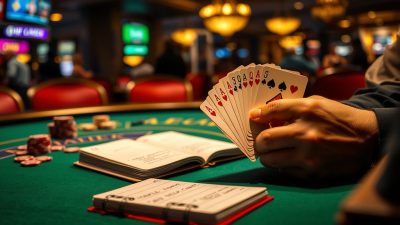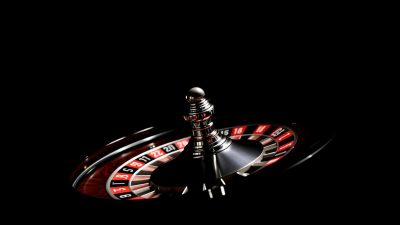Effective Poker Bluffing Strategies We Use to Win
Welcome to our playbook for turning uncertainty into opportunity. At our tables, every move is a calculated step toward victory. We’ve built our success on mastering the delicate dance of convincing opponents to fold, even when the odds aren’t in our favor.

Bluffing isn’t about luck—it’s about precision. We focus on timing, bet sizing, and reading the room. When done right, a well-placed raise can turn weak hands into winning ones. The key? Making others believe your story more than their own cards.
Balance is everything. We mix aggressive plays with smart value bets to keep rivals guessing. This guide will walk you through techniques like range balancing and semi-bluffing, showing how to spot weaknesses in others’ strategies. You’ll learn to use position, board texture, and opponent tendencies to your advantage.
What separates good players from great ones? The ability to blend math with intuition. We’ll share real-world examples and actionable tips honed through countless hours at high-stakes tables. Let’s transform your game—one bold move at a time.
Understanding the Basics of Poker Bluffing
Every decision at the table tells a story. Bluffing acts as the pen that writes it. At its core, this tactic involves betting or raising to convince others you hold stronger cards than reality. We use it to push rivals into folding better hands—a psychological dance where confidence meets calculation.
Timing shapes success. Bet too small, and opponents call. Bet too large, and they smell deception. We watch for hesitation patterns or inconsistent sizing from others—these often reveal vulnerability. When someone checks repeatedly or slows their actions, it’s time to strike.
Key terms matter. The flop, turn, and river stages dictate opportunities. A dry board (few possible draws) favors bold moves, while coordinated boards demand caution. Position also plays a role—acting last grants more information to craft believable bets.
Not all bluffs are nuclear strikes. Subtle pressure works too. Mixing small aggression with occasional big plays keeps your image balanced. Mastery begins here: knowing when to push and when to fold becomes second nature.
The Theory Behind Successful Poker Bluffing
Game theory isn’t just for textbooks—it’s the backbone of winning plays. We calculate expected value by weighing potential gains against the risk of failure. Every decision considers two questions: What do we stand to win, and how likely are opponents to fold?

Balancing actions keeps rivals guessing. When our bets represent strong hands 60% of the time and strategic bluffs 40%, we create maximum uncertainty. This ratio pressures others into costly mistakes, especially on the river where final decisions happen.
Opponents’ habits dictate our moves. A player who overfolds on scary boards becomes a prime target. We track betting sizes and timing tells—quick checks often signal weakness, while delayed raises suggest strength.
Stack sizes shape our approach. Deep stacks allow bold moves, while short stacks demand precision. Consistent bet sizing sells our story, whether we’re holding gems or gravel.
Mastering Poker Bluffing Strategies
Mastering the invisible strings of deception separates experts from amateurs. We build our approach around two core concepts: polarized and merged ranges. Polarized ranges include either premium hands or total air, while merged ranges contain medium-strength holdings. Choosing between them depends on your opponent’s tendencies and board texture.
Bet sizing becomes an art form here. On dry boards, we overbet 150% of the pot to pressure tight opponents. Against calling stations, smaller 60% pot bets work better. The goal? Make rivals question whether folding costs more than calling.
| Range Type | When to Use | Bet Size Example |
|---|---|---|
| Polarized | Scare cards hit | 120% pot on river |
| Merged | Multi-way pots | 75% pot on turn |
| Balanced | Heads-up games | 50-100% pot variance |
Your table image dictates opportunities. If you’ve shown down strong hands recently, bluffs gain credibility. We track opponents’ fold percentages in different positions—late spots allow more aggression.
Practice makes permanent. Start by bluffing 20% of your river bets, adjusting based on reactions. Remember: consistency sells the story. Mix in value hands that mirror bluff patterns to keep rivals off-balance.
Reading Opponents: Tells, Images, and Betting Stories
The unspoken language of chips and glances holds more truth than cards ever could. We decode rivals through micro-expressions and bet patterns—tools sharper than any math.

Physical tells reveal hidden weaknesses. Rapid eye movements often signal uncertainty. White-knuckled chip stacks suggest forced confidence. Watch for throat swallows before big bets—they’re involuntary stress responses. Even online, cursor hesitation or delayed timers can betray nervousness.
| Tell Type | Weakness Signal | Action to Take |
|---|---|---|
| Eye Contact | Over-staring = fabricated strength | Raise 75% pot |
| Hand Tremors | Anxiety about showdown | Bluff river bets |
| Bet Speed | Instant all-in = desperation | Call with mid-range hands |
Table images shape decisions. A tight player’s sudden aggression screams premium holdings. But if they’ve shown three bluffs recently? Their fourth raise is likely air. We track rivals’ histories like detectives—yesterday’s timid caller becomes today’s target.
Timing tells whisper secrets. Quick checks often mask weakness, while long pauses before raises hint at genuine strength. In the 2023 WSOP Main Event, a two-second delay in a bet sizing adjustment exposed a failed bluff attempt.
Practice spotting mismatches between bets and body language. Start by observing one opponent per session. Soon, you’ll see the cracks in their armor—and know exactly when to strike.
Balancing Your Hand Range: When to Bluff and When to Value Bet
Your cards tell half the story—your bets write the ending. We balance hand ranges to keep opponents guessing whether we’re holding gems or gravel. The goal? Make every bet look equally threatening, whether we’re pushing air or monsters.
Polarized ranges contain extreme ends: premium hands or total bluffs. Merged ranges blend medium-strength holdings. We choose based on board texture. Dry flops with few draws favor polarized aggression. Coordinated boards demand merged approaches to protect weaker holdings.
| Range Type | Best Use Case | Frequency Ratio |
|---|---|---|
| Polarized | Heads-up on scary rivers | 2 value : 1 bluff |
| Merged | Multi-way pots | 3 value : 2 bluff |
| Balanced | Early tournament stages | 1:1 adjustments |
Bet sizing sells your narrative. We match bluff bets to value bet sizes—identical amounts for both. If you raise 80% pot with strong hands, do the same with bluffs. Opponents can’t exploit patterns they can’t decode.
Adjust based on opponent behavior. Against cautious players, increase bluffs on turn cards that complete draws. Versus aggressive rivals, tighten your range and let them overcommit. Track fold percentages in different positions to refine your ratios.
Practice blending these concepts in low-stakes games. Start with polarized river bets, then experiment with merged flop raises. Consistent execution builds an unreadable table image—your ultimate weapon.
The Art of Semi-Bluffing for Pot Building
In high-stakes moments, the semi-bluff becomes our Swiss Army knife—versatile and sharp. This move lets us build pots aggressively while holding backup equity. Unlike pure bluffs, we bet with hands that can improve on later streets, like flush draws or open-ended straights.
We categorize holdings into four types: strong made hands, marginal pairs, drawing hands, and complete air. Semi-bluffing targets the third group—hands with low showdown value but high potential. For example, raising with a 9♠8♠ on a 7♠2♦K♠ flop applies pressure while keeping 15 outs to improve.
| Hand Type | Action | Equity Potential |
|---|---|---|
| Flush Draw | Raise 70% pot | 35% on turn |
| Gutshot Straight | Call/Check-Raise | 17% improvement |
| Overcards | Small Continuation Bet | 30% hit chance |
Timing matters most. We strike on the flop or turn when opponents show hesitation. A 60-75% pot bet often works best—large enough to pressure folds, small enough to justify chasing draws. If called, our equity remains live for the river.
Storytelling sells the play. We mirror bet sizes used with strong hands, making our semi-bluff indistinguishable from premium holdings. Against tight players, this tactic forces tough decisions. Against callers, we retain multiple winning paths.
Master this by tracking two factors: your hand’s improvement odds and rivals’ folding frequencies. Start with flush draws in late position, then expand to other scenarios. Balance becomes your ally—mix semi-bluffs with genuine monsters to keep the table guessing.
Advanced Bluffing Tactics and Real-Life Examples
Elevating your game requires moves that defy conventional wisdom. We target opponents’ mental gaps with precision strikes—tactics that turn uncertainty into profit. Consider the 3-bet light against tight players: re-raising preflop with hands like 7♣6♣ forces folds from premium holdings. In a 2023 WSOP event, this move secured a $120k pot against a player who overfolded to aggression.
Double floating—calling both flop and turn bets with air—works best against predictable c-bettors. We once claimed a $25k cash game pot by floating a K♦9♠4♥ board, then shoving river when our rival’s bet sizing revealed weakness. The key? Matching storylines to board texture and opponent tendencies.
| Tactic | Best Scenario | Real-World Result |
|---|---|---|
| Turn Probe Bet | Check-call flop heads-up | 72% fold equity in $5/$10 games |
| Delayed C-Bet | Multi-way pots | 58% success rate post-flop |
| Overbet Shove | Short-stacked tournaments | 2024 PCA $50k win using 200% pot river bets |
Adjust bet sizing on later streets to maximize pressure. Against a calling station, we once won a critical hand by betting 33% pot on river—a size too tempting for them to fold middle pair. Start small: test these moves in low-stakes games to refine timing and build confidence.
Adapting Bluffing Techniques for Different Formats
Bluffing isn’t one-size-fits-all. We adjust our approach based on whether we’re facing cash game grinders or tournament survivors. In cash games, deeper stacks allow more post-flop maneuvering, while tournaments demand urgency as blinds escalate.

Against tight opponents in tournaments, we increase bluffs on bubble stages. Loose cash game players? We tighten up and strike when scare cards hit. Table dynamics shift dramatically between $1/$2 and $25/$50 games—higher stakes mean sharper reads and faster adjustments.
| Format | Bluff Frequency | Key Adjustment | Example |
|---|---|---|---|
| Cash Games | Lower (15-20%) | Target weak callers post-flop | Bluff river when flush completes |
| Tournaments | Higher (25-30%) | Exploit short-stack desperation | 3-bet bluff antes with A5s |
| High Stakes | Balanced | Vary bet sizing per opponent | 55% pot vs. 80% pot mixes |
Bet sizing tells different stories across formats. In low-stakes cash, we use 70% pot bets for consistency. Tournaments require 50-120% sizing swings to pressure survival-minded players. We track stack-to-pot ratios religiously—it dictates when to push or fold.
Adaptation never stops. We recalibrate every orbit, watching for shifts in opponents’ folding frequencies. Last week, switching from 3-bet bluffs to check-raise traps against a tight table netted 47% more folds. Stay fluid, stay profitable.
Customizing Our Strategy Based on Table Dynamics and Opponent Profiles
Adaptation is the heartbeat of profitable play. We craft unique approaches for every table, treating each opponent as a puzzle needing specific solutions. Rigid plans fail here—flexibility wins.
Table dynamics dictate our first adjustments. Loose games with frequent callers demand fewer bluffs but larger bet sizes. Tight tables? We increase aggression on scare cards like paired boards or flush completions. Monitoring fold percentages in real-time helps us shift gears seamlessly.
Opponent profiling separates break-even players from winners. We categorize rivals into four types:
| Player Type | Key Tells | Our Adjustment |
|---|---|---|
| Tight Passives | Folds to 60% river bets | Bluff turn/river more |
| Loose Callers | Calls 3 streets with mid-pair | Value bet thinly |
| Aggressive Regs | 3-bets light preflop | Check-raise traps |
Live games reveal physical tells—shaking hands during big decisions often signal weak holdings. Online, we track bet timing. A player who insta-checks flops after raising preflop? Prime target for continuation bets.
Bet sizing adapts to stack depths and tendencies. Against short stacks, we use 80% pot bets to pressure all-in decisions. Deep stacks allow smaller 50% probes to build pots gradually. Last week, adjusting from 3x to 2.5x preflop raises against observant regs increased our steal success by 18%.
Evolving dynamics require constant recalibration. We reassess every orbit—yesterday’s calling station might today morph into a nit. Stay curious, stay fluid, and let the table write your next move.
Conclusion
Our journey through these concepts shows that winning lies in balance. Blending calculated risks with precise value bets creates pressure opponents can’t ignore. We’ve shared how to read tendencies, adapt to board textures, and craft believable stories through bet sizing.
Remember—success demands constant evolution. What works against cautious players fails versus aggressive rivals. Track folding patterns, refine your ratios, and practice adjusting mid-game. The best hands mean little without the wisdom to wield them.
We invite you to test these ideas at your next session. Share your breakthroughs and challenges with our community. Together, we’ll keep refining this craft, turning subtle adjustments into consistent victories.
Ready to level up? Dive deeper into position play and equity calculations. Every session is a chance to sharpen your edge. Let’s build your legacy—one smart decision at a time.





